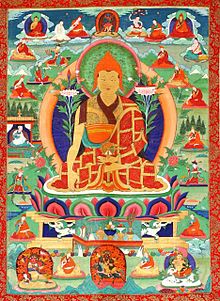Taranatha

| Part of a series on |
| Tibetan Buddhism |
|---|
 |
Tāranātha (1575–1634) was a Lama of the Jonang school of Tibetan Buddhism. He is widely considered its most remarkable scholar and exponent.
Taranatha was born in Tibet, supposedly on the birthday of Padmasambhava. His original name was Kun-dga'-snying-po, the Sanskrit equivalent of which is Anandagarbha. However, he adopted Taranatha, the Sanskrit name by which he was generally known, as an indication of the value he placed on his Sanskrit scholarship in an era when mastery of the language had become much less common in Tibet than it had once been. He was also paying homage to his Indian teacher, Buddhaguptanatha.[1]
His exceptional qualities are said to have been recognized by others at a young age, as is often the case with great masters. He studied under such masters as Je Draktopa, Yeshe Wangpo, Kunga Tashi and Jampa Lhundrup, although his primary teacher was Buddhaguptanatha.
Taranatha was recognized by Khenchen Lungrik Gyatso as the rebirth of Krishnacarya and the Khenchen's own teacher, Jetsun Kunga Drolchok.[2]
Works[edit]
Taranatha was a prolific writer and a renowned scholar. His best known work is the 143-folio History of Buddhism in India (dpal dus kyi 'khor lo'i chos bskor gyi byung khungs nyer mkho) of 1608,[3][4][5] which has been published in English. Other works are The Golden Rosary, Origins of the Tantra of the Bodhisattva Tara of 1604 which has also been translated into English. He was an advocate of the Shentong view of emptiness and wrote many texts and commentaries on this subject. English-language translation publications of his works on Shentong are The Essence of Other-Emptiness[6] (which includes a translation of his Twenty One Profound Meanings (Zab don gсer gcig pa)) and his Commentary on the Heart Sutra.[7] In 1614 Taranatha founded the important Jonangpa monastery Takten Dhamchöling, in the Tsangpo Valley about 200 miles west of Lhasa.
Later life[edit]
Probably not long after 1614, Taranatha went to Mongolia, where he reportedly founded several monasteries. He died probably in Urga. His rebirth became known as Zanabazar, the 1st Bogd Gegeen and Jebtsundamba Khutuktu of Mongolia. His most recent reincarnation was the 9th Jebtsundamba Khutughtu, who died in 2012.
See also[edit]
References[edit]
- ^ "Buddhaguptanatha and the Late Survival of the Siddha Tradition in India," by David Templeman
- ^ Stearns, Cyrus (August 2008). "Tāranātha". The Treasury of Lives: Biographies of Himalayan Religious Masters. Retrieved 2013-08-10.
- ^ Synopsis by Nalinaksha Dutt, Chap. I-XIII Archived March 4, 2009, at the Wayback Machine
- ^ Chap. XIV-XXVI Nagarjuna, Asanga, Vasubandhu, Dharmakirti, Shantideva and Shri Harsha Archived March 4, 2009, at the Wayback Machine
- ^ Chap. XXVII-XLIV Accounts of Pala, Sena kings, Vikramshila, Turushkas and status of Buddhism in India, Sri Lanka and Indonesia Archived May 28, 2008, at the Wayback Machine
- ^ The Essence of Other-Emptiness by Taranatha, translated and edited by Jeffrey Hopkins (Snow Lion, 2007) ISBN 1559392738
- ^ Taranatha's Commentary on the Heart Sutra by Adele Tomlin (Library of Tibetan Works and Archives, 2017) ISBN 938702301X
Sources[edit]
- Taranatha (auth.), Hopkins, Jeffrey (trans). The Essence of Other-Emptiness Snow Lion(2007). ISBN 1-55939-273-8
- Stearns, Cyrus. The Buddha from Dolpo: A Study of the Life and Thought of the Tibetan Master Dolpopa Sherab Gyaltsen. State University of New York Press (1999). ISBN 0-7914-4191-1 (hc); ISBN 0-7914-4192-X (pbk). -(contains fairly extensive information on Taranatha)
Further reading[edit]
- Tharanatha; Chattopadhyaya, Chimpa, Alaka, trans. (2000). History of Buddhism in India, Motilal Books UK, ISBN 8120806964.
- Tāranātha's Edelsteinmine, das Buch von den Vermittlern der sieben Inspirationen / aus dem Tibetischen übers. von Albert Grünwedel. - Petrograd: Imprimerie de l'Académie Impériale des Sciences, 1914 PDF
- Tāranātha's Geschichte des Buddhismus in Indien. Aus dem Tibetischen übersetzt von Anton Schiefner. St. Petersburg: Kais. Akademie der Wissenschaften 1869. XII. St. Petersburg 1869. PDF
- Tāranātha-‘Dzam-Thang-edition-complete-23-volumes
- Tāranātha-Ladakh-edition-complete-17-volumes
- Tāranātha-pe-cin-edition-complete-45-volumes
External links[edit]
- The Life of Zanabazar
- The Jonang Foundation on Taranatha
- The Jonang Dharma on Taranatha
- Stearns, Cyrus (August 2008). "Tāranātha". The Treasury of Lives: Biographies of Himalayan Religious Masters. Retrieved 2013-08-10.
